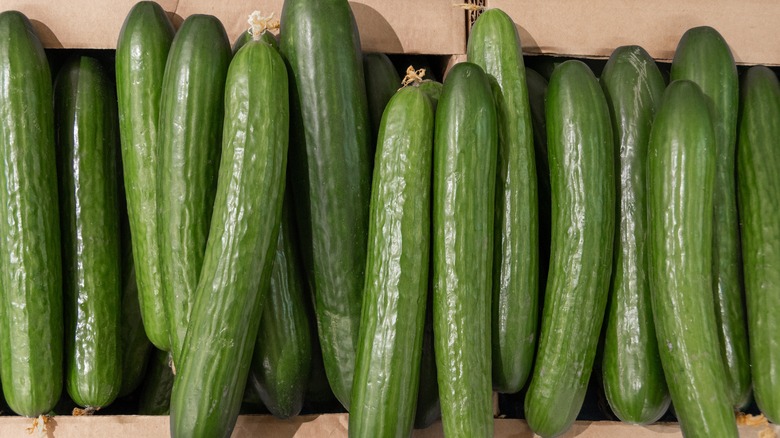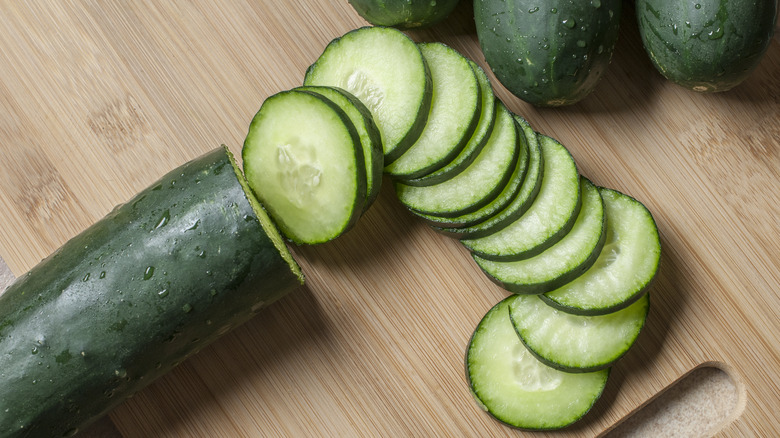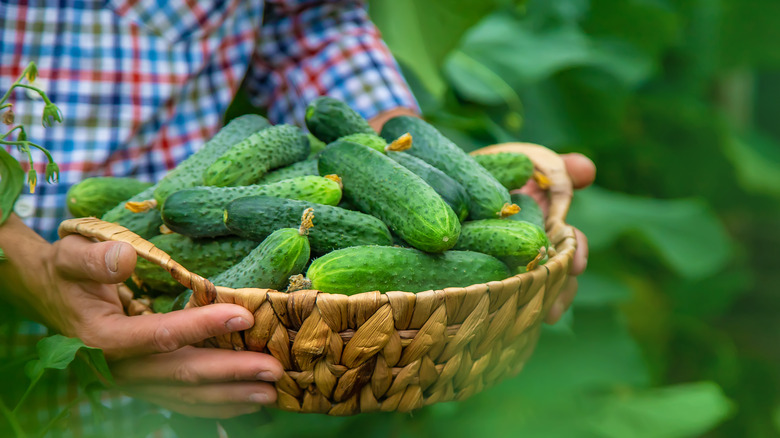The Simple Rule For Choosing The Best Cucumbers At The Grocery Store
If you've been casually tossing cucumbers in your grocery cart for as long as you can remember, it's time to slow down and reconsider. Not all cucumbers are created equal. Or at least some cucumbers are harvested at peak moments, and some are not. But how do you know which cucumbers are ready to eat and which aren't? The secret is to seek out cukes that are deep, dark green all the way around with no yellow streaks or blotches.
Cucumbers are not actually picked when they're fully grown and matured, so it's not quite accurate to call them ripe. Instead, farmers pick them at the exact right point where the texture is firm, the skin is thin, and there aren't tons of big seeds inside. It's a small window of time, however, and lots of cucumbers sneak past those standards, so if you're on the hunt for ingredients for the perfect cucumber salad or sandwich, just be sure you know what to look for before you hit the farmer's market or produce section.
As cucumbers ripen, they get bitter
Cucumbers come in a couple of different varieties, but when we think about eating fresh cucumbers, we're thinking about slicing cucumbers. The other major variety is pickling cucumbers, which are smaller and bumpier. English cucumbers, by the way, are just a different variety of slicing cucumber that has fewer seeds than their American counterparts.
Slicing cucumbers take as many as 70 days to grow after planting. But once the fruit starts to form (yes, botanically speaking, they're actually fruits because they grow from flowers and contain seeds), ripening happens fast. If you've ever grown veggies, you know it's not unusual for a vine to have a beautiful green cucumber one morning, only for it to turn yellow in a day or two. It's important to grab that cucumber when it's in peak, green form because as the fruits mature, the flavor turns from sweet to bitter. This is caused by a compound known as cucurbitacin, which is in every cucumber but increases as the cucumber grows and matures. When the skin of a cucumber starts to turn yellow, that's your cue to know that it's got a lot of cucurbitacin and to steer clear.
Cucumbers are edible even when they're yellow
The nice thing about green cucumbers is that they do not continue to ripen once they're picked, so you don't have to worry about overripening after you get them home. But if you've already got some cucumbers with yellow streaks, don't worry too much about it. Cucumbers are still edible at any stage of their development, they just won't have the same crisp texture and subtle sweetness as younger fruits.
If you end up with overly mature cucumbers, either because you didn't know what to look for at the grocery store or market or your neighbor with too many cucumbers in their garden dropped them off on your doorstep, all you have to do is peel the tough skins away as you would with asparagus, then scoop out the seeds. More mature cucumbers aren't the best choice for recipes where they're the stars of the show, like cucumber salad, but they'll taste great with some creamy salad dressing. Even better, you can slice them up and serve them in a refreshing gin and tonic in place of lime since you'll already be expecting the slight bitterness from the gin. It's the perfect summer cocktail, especially when there are lots of cucumbers to eat.


